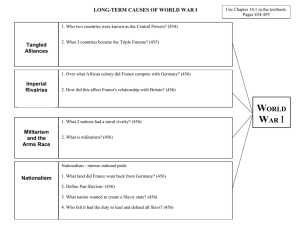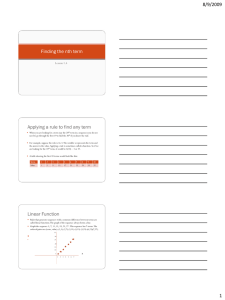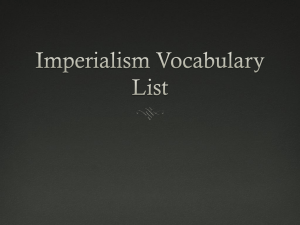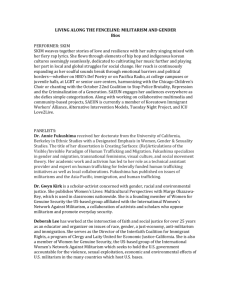learning and teaching strategies japan oct07
advertisement
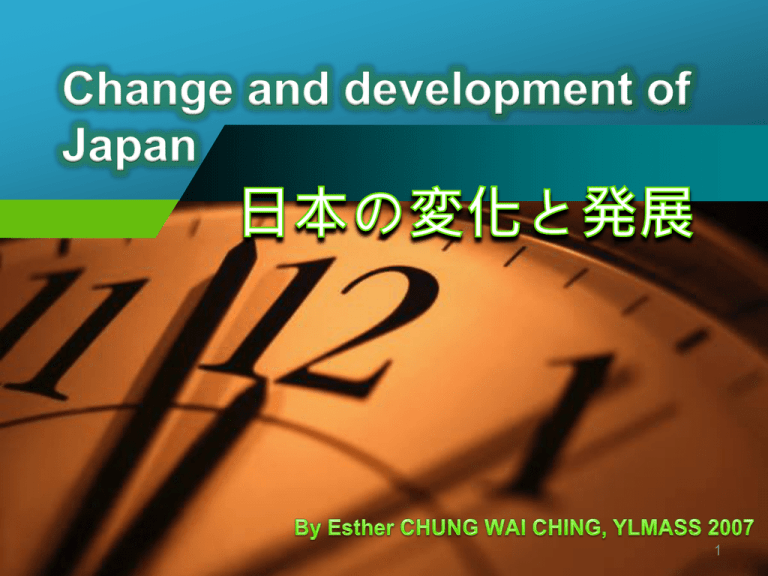
1 Change and development of Japan Content Focus • Overview the political, social, economic and cultural conditions in the early 20th century • Factors for the rise of militarism and its impact • Factors for postwar economic growth • Relations with other Asian countries (Political, economic and cultural) 2 Overview of the political, social, economic and cultural conditions in the 20th century Early 20th Century Meiji Period Taisho Period Showa Period [1868-1912] [ 1912-1926] [1926-1989 ] 3 Overview of the political, social, economic and cultural conditions in the 20th century • • • • Political conditions Social conditions Economic conditions Cultural conditions 4 Overview of the political, social, economic and cultural conditions in the 20th century Political Conditions 1. Democratic Development Meiji Constitution Rise of political parties, e.g. Seiyukai (政友會) & Minseito (民政黨) Rise of ultra-nationalist activities How democratic? 5 Overview of the political, social, economic and cultural conditions in the 20th century 2. Foreign Relations 1900-01: Eight-Power Expedition 1902: Anglo-Japanese Alliance 1904-05: Russo-Japanese War 1914-18: WWI 1921-22: Washington Conference 1924-27 & 29-31: Shidehara Diplomacy 1931: Shenyang Incident Relations: • friendly? peaceful? hostile? • change and continuity 6 Overview of the political, social, economic and cultural conditions in the 20th century Social Conditions 1. Westernized? Traditional? Westernized: • Social equality • Western style of living: e.g. food, clothing, ceremony, western movies, Traditional: •Food, e.g. Sushi, Sashimi •Religious ceremonies •Kimono 7 Overview of the political, social, economic and cultural conditions in the 20th century Social Conditions 1. Westernized? Traditional? Westernized: • Social equality • Western style of living: e.g. food, clothing, ceremony, western movies, Traditional: •Food, e.g. Sushi, Sashimi http://www.youtube.com/watch?v=yw8y I2giR14 •Religious ceremonies •Kimono (和服) 8 Overview of the political, social, economic and cultural conditions in the 20th century 2. Prosperity? Poverty? Urbanization Widening gap between the urban and rural areas 9 Overview of the political, social, economic and cultural conditions in the 20th century 3. High degree of freedom? 10 Overview of the political, social, economic and cultural conditions in the 20th century The women's class of the Iwate Teachers' School., 1914 Basic human rights under the Meiji Constitution Many labour organizations & movements 1920: New Women’s Association Extent of the freedom? 11 Overview of the political, social, economic and cultural conditions in the 20th century Economic Conditions 1. Economic prosperity? Rapid industrialization & strong influence of Zaibatsu Mitsubishi (三菱) Mitsui (三井) Sumitomo (住友) Yasuda (安田) A Match Factory in Late Taisho 12 Overview of the political, social, economic and cultural conditions in the 20th century 2. Economic Ups and Downs Economic boom: Economic bust: • 1923: Great Tokyo Earthquake • 1927: Bank Crisis • 1929: Great Depression 13 Overview of the political, social, economic and cultural conditions in the 20th century Cultural Conditions 1. Western Culture? Traditional Culture? -Western and Japanese movies, drama -Shintoism (state religion), Confucianism, Ukiyo-e (浮世澮) 14 Overview of the political, social, economic and cultural conditions in the 20th century Characteristics: Pseudo-democracy Bi-polarisation Co-existence of westernization and tradition Race between freedom and power/authority Alternation of amity and hostility 15 Factors for the Rise of Militarism & its Impact Rise of Militarism 16 Factors for the Rise of Militarism & its Impact Factors of the Rise of Militarism 1. Militaristic Tradition 17 Factors for the Rise of Militarism & its Impact Factors of the Rise of Militarism 2.Weaknesses of the Party Government Corruption of the Parties Lack of Mass Support Economic Crises 18 Factors for the Rise of Militarism & its Impact Factors of the Rise of Militarism 3. Rise of domestic needs A Japanese poster recruiting youngsters to join the army to invade Manchuria A Japanese poster promoting emigration to Korea and Manchuria in the 1930s 19 Factors for the Rise of Militarism & its Impact Factors of the Rise of Militarism 4. Inglorious Foreign Policy Japan in Washington Conference Japan in London Naval Conference of 1930 20 Factors for the Rise of Militarism & its Impact Factors of the Rise of Militarism 5. Rise of Extreme Nationalistic Ideas 6. Western Discrimination 7. International Circumstances 21 Factors for the Rise of Militarism & its Impact • Reasons for the Rise of Militarism Militaristic Tradition Weaknesses of the Party Government Western discrimination against Japan Inglorious Foreign Policy Growing domestic needs Rise of Extreme Nationalistic Ideas International Situation •Relations between conditions in the early period and the rise of militarism •Relative importance? 22 Factors for the Rise of Militarism & its Impact Characteristics of militarism: • • • • • Emphasis on the use of force Stress on absolute loyalty and obedience Promotion of foreign expansion Pan-Asianism Anti-communism Factors for the Rise of Militarism & its Impact Impact on Japan’s Relations with other countries Impact of the Rise of Militarism 24 Factors for the Rise of Militarism & its Impact Impact of the Rise of Militarism Foreign Expansion Just this one? 25 Factors for the Rise of Militarism & its Impact Impact of the Rise of Militarism Impact on Japan’s domestic development Rise of extreme nationalists Militaristic associations Political instability Collapse of the party government 26 Factors for the Rise of Militarism & its Impact Impact on Japan’s domestic development Political Control of the militarists Suppressive livelihood 27 Factors for Postwar Economic Growth Stages of the Postwar Economic Growth 1. Economic Reconstruction (1945 – 1952) 2. Economic Boom (1955 – 70) 3. Period of Transformation(1971 - 79) 4. Economic Slowdown(1980 onwards) 28 Factors for Postwar Economic Growth Postwar Economic Situation Hiroshima after WWII Nagasaki after WWII 29 Factors for Postwar Economic Growth Postwar Economic Situation 百年物語 disk2 30 Factors for Postwar Economic Growth • Reasons for each period??? • Common Factors??? 31 Factors for Postwar Economic Growth • Common Factors Role of the US: SCAP & Post-SCAP Policies Active Role of the Japanese Government National Characters of the Japanese Favourable International Circumstances Importance? Relative Importance? 32 Factors for Postwar Economic Growth Economic recovery Open-air shopping street in 1945 33 Factors for Postwar Economic Growth Economic recovery A shopping street in 1955 34 Jusco in the 1970s. Relations with Other Asian Countries • Political Relations • Economic Relations • Cultural Relations 35 Relations with Other Asian Countries 36 Relations with Other Asian Countries • Chronological approach 1950s 1960s 1970s 1980s and after •Problem: confined to political and economic aspects 37 •Relations with Other Asian Countries Thematic approach Political: improving relations with Asian countries Obstacles: • Denials of Aggression • Official visits to Yasukuni Shrine • Denials to Asian people's Quest for War Compensation • Territorial Disputes with China •Change and continuity?? 38 Relations with Other Asian Countries Thematic approach Economic: From limited economic contact to strengthening economic relations with Asian countries •Change and continuity?? 39 Relations with Other Asian Countries Thematic approach Cultural: increasing cultural influences of Japan in Asian countries •Change and continuity?? 40 Change and development of Japan: Highlights • Compare economic conditions between the early 20th century and late 20th century. • Compare foreign relations between the early 20th century and late 20th century. • Can we need to compare political, social and cultural conditions of Japan between the early 20th century and late 20th century?? • Compare the Meiji Constitution and Showa Constitution??? – Please check the Curriculum Guide!!!! Of course!!! no need!!! 41 Change and development of Japan: Highlights • What are the characteristics of the political, social, economic and cultural conditions in the early 20th century Japan? • What economic problems did Japan face? What attempts did the government make to solve them? • Was Japan a liberal country in the early 20th century? 42
